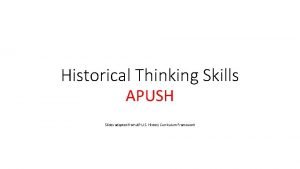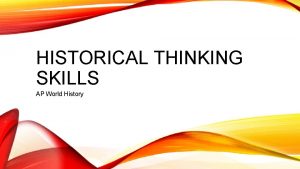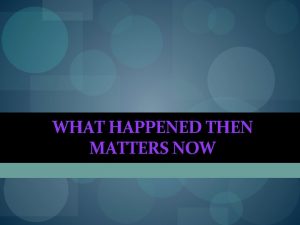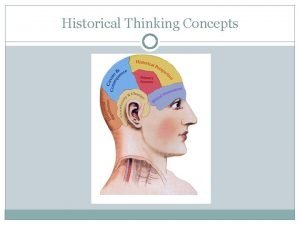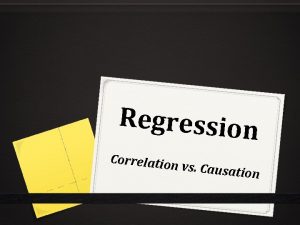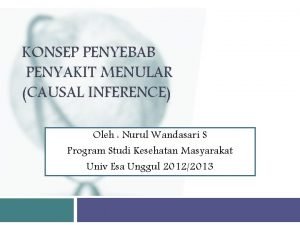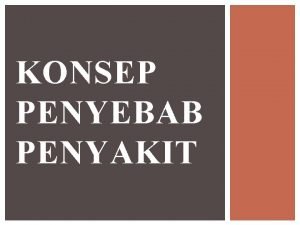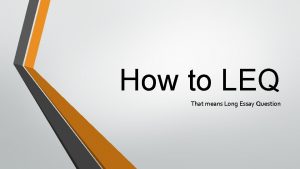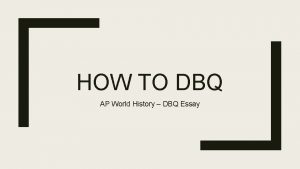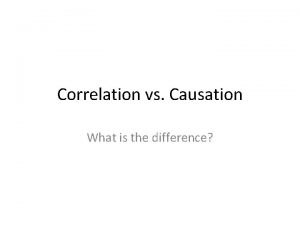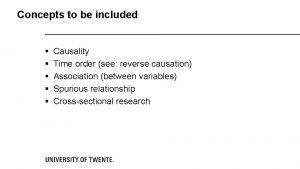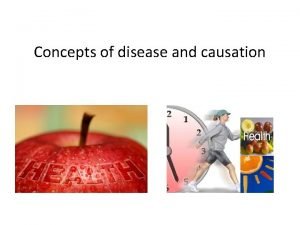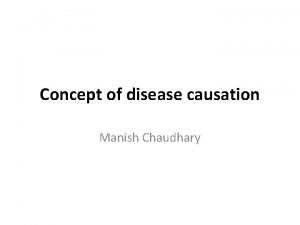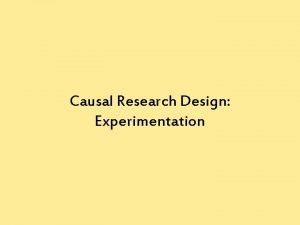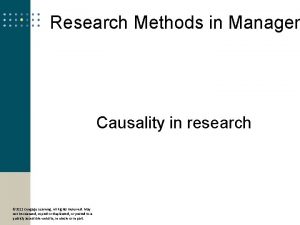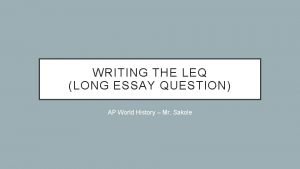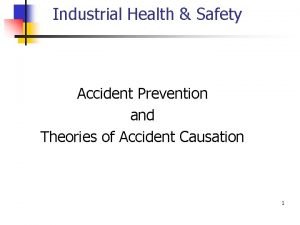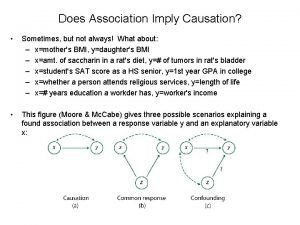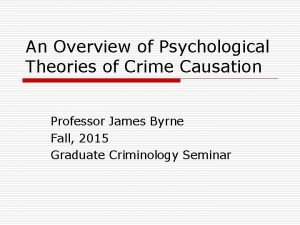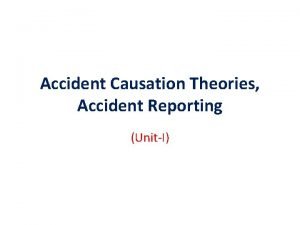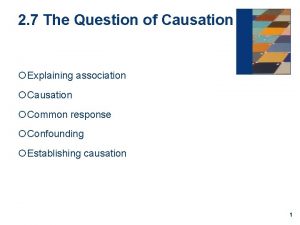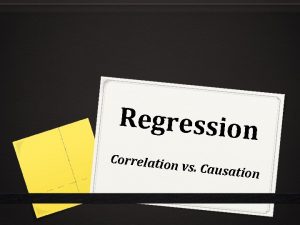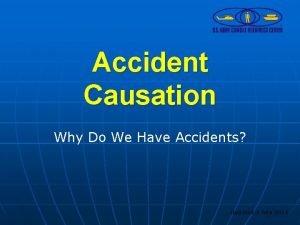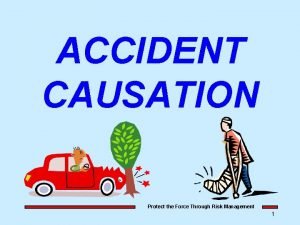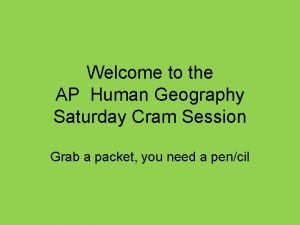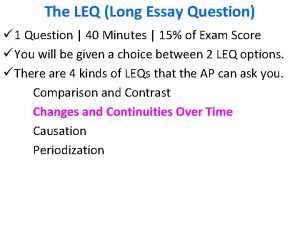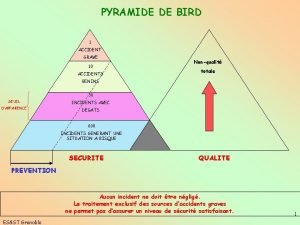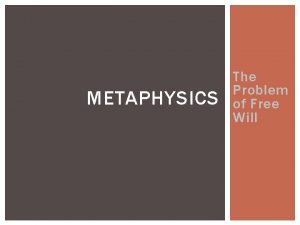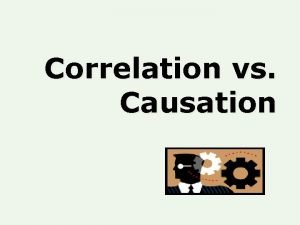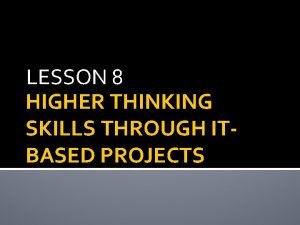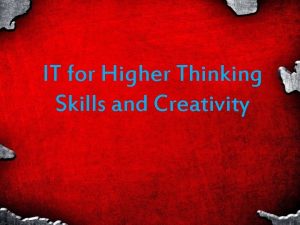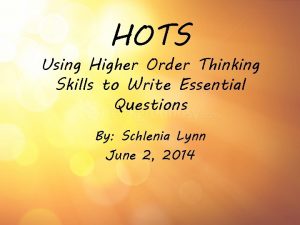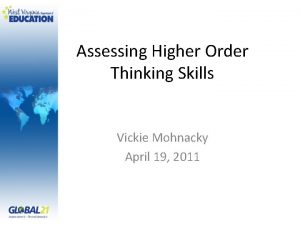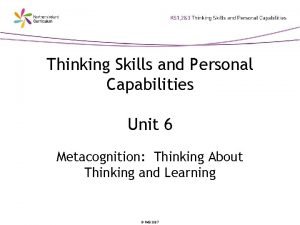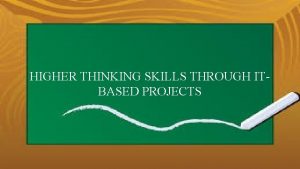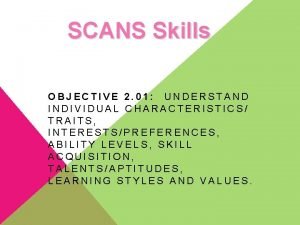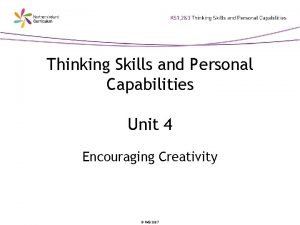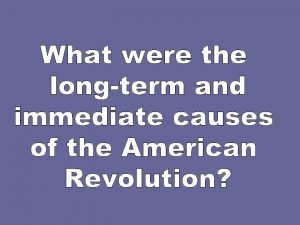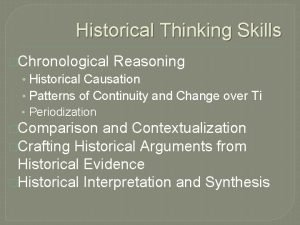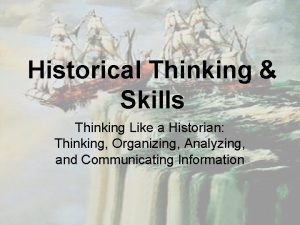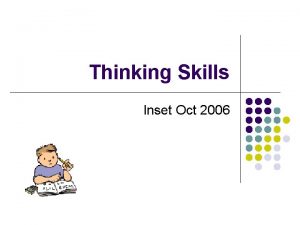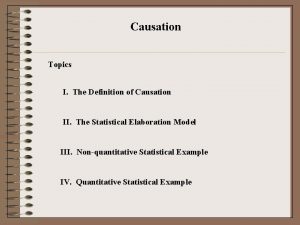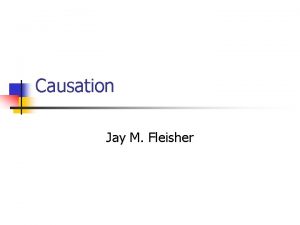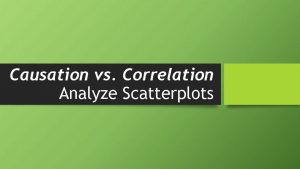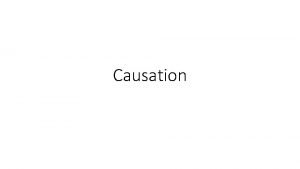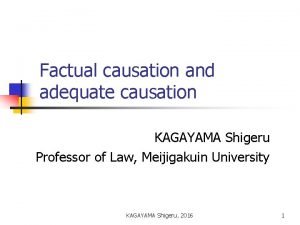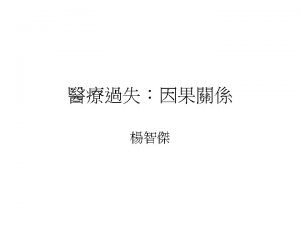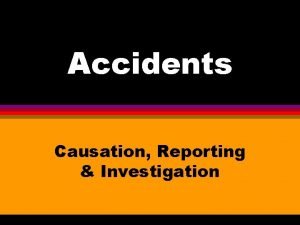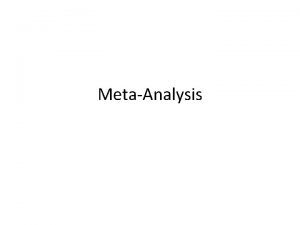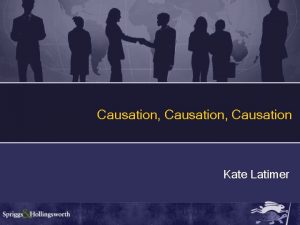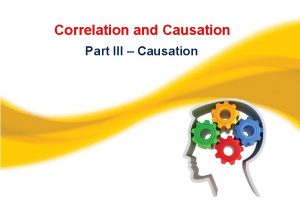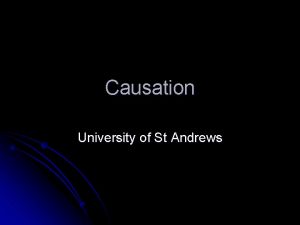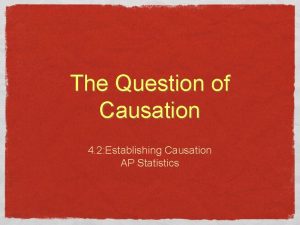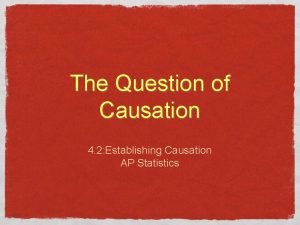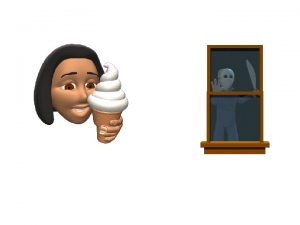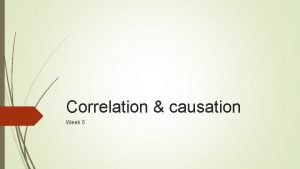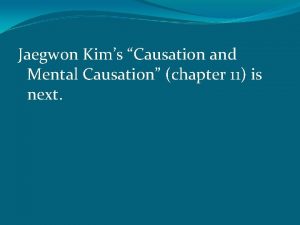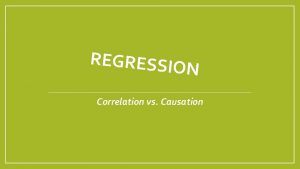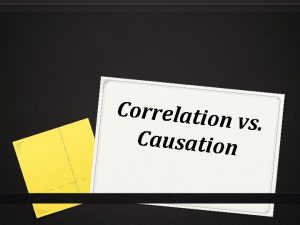Historical Thinking Skills Historical Causation Why did the


































![What goes here? Historical Context The [name of doc] from [time/place/author] relates to the What goes here? Historical Context The [name of doc] from [time/place/author] relates to the](https://slidetodoc.com/presentation_image/118dc8598d7e440f4c688db1ae16150d/image-35.jpg)


















- Slides: 53

Historical Thinking Skills!

Historical Causation Why did the event happen? What was the impact? Think both long and short term! Practice: How did Bacon's Rebellion lead to race-based system of slavery?


Continuity and Change Over Time What stayed the same? What changed? Why did it change and how much did it change? How do Dred Scott, Plessy and Brown reflect change and continuity over time regarding race relations?


Periodization Why do historians start and end time periods when they do? Turning points! When did the Progressive Era begin? Or why does this course begin in 1491?


Comparison Identify similarities and differences within a society or between societies—could be chronological, ideological, demographic, geographic, political, economic, or social. 1920 s vs. 1950 s


Contextualization Connecting events to their specific place and time in history. Put the Indian Wars in context of trends in America from 1865 -1890. How do these events contribute to understanding American westward expansion?


Historical Argumentation Evaluating and synthesizing conflicting historical evidence to construct persuasive historical arguments. Examining multiple piece of evidence in concert with each other, noting contradictions, corroborations, and other relationships among sources to develop and support an argument. John Smith vs Powhatan oral history? John Smith didn't claim a relationship with Pocahontas until she went to England, met the queen and became a celebrity.

Appropriate Use of Relevant Historical Evidence Extracting useful information, making supportable inference, & drawing appropriate conclusions from historical evidence. Evaluating the usefulness, reliability, or limitations of a primary source in answering a particular historical question. The Civil War is such a big subject with tens of thousands of books written on the subject. Approach it this way: what evidence would be used by military historians? Medical? Gender? Labor?

Interpretation How do perspectives influence people’s interpretations of events, and how might these perspectives change over time? Can we condemn Jefferson as a hypocrite or is this presentism or personal bias? Was Lincoln the great or reluctant emancipator?

Synthesis Creating a persuasive understanding of the past and its relevance to the present by thinking across time periods and connecting ideas, people, and events. What do these have in common, and what can one learn from them? Synthesis can be a forward or backward reflection on the circumstances surrounding the topic. John Brown as being both a hero and a terrorist, Teddy Roosevelt being both a champion of the people and a supporter of big business

Structuring ‘The Hudenburg Method ‘ Essay • Introduction (easier than you think!)—connect the prompt to the previous time • Thesis: I would suggest it be the last sentence in first paragraph (but not required) • Thesis must answer the question completely • Introduces the categories that will be used in answering the question • Does not need to be a single sentence • Body Paragraphs: • Each has a unique theme; there is nothing sacred about a 3 body paragraph essay • Begin each paragraph with a topic sentence which defends your thesis and answers the question in this paragraph • Your paragraph should include many pieces of SFI and IC (Interpretive Commentary)—where you prove what you write. • Give a fact what the fact is why is it significant and tie to your thesis • Show an understanding of how & why this information supports thesis! • Conclusion: • A good place to modify or prove your thesis; include the x factor ‘However a case could be made that …” • End your essay by connecting the prompt to another era coming afterward. Intro. Thesis Topic Sent. SFI IC

Brainstorming is important! You have to have a plan going into an essay!

Some Key Terms: The Industrial Revolution & the Rise of Sectionalism James Monroe Andrew Jackson Henry Clay Robert Fulton Eli Whitney Francis Lowell Samuel Slater John Quincy Adams Nat Turner Era of Good Feelings American System Adams-Onis Treaty Monroe Doctrine Industrial Revolution Missouri Comp. Election of 1824 “Favorite Sons” Election of 1828 2 nd Bank of the US Corrupt Bargain Mudslinging Erie Canal National Road Railroads Steam Engine Cotton Gin Interchangeable Parts Lowell Textile Mills Planters and Plantations Slave Gang System Task System Slavery Slave Codes Tallmadge Amendment King Cotton Tariffs Force Bill Secession With a partner… can you classify these terms into these three categories? P = Political E = Economic S = Social

Political James Monroe Andrew Jackson Henry Clay John Quincy Adams-Onis Treaty Monroe Doctrine Missouri Compromise Election of 1824 “Favorite Sons” Election of 1828 Corrupt Bargain Mudslinging Economic Robert Fulton Eli Whitney Francis Lowell Samuel Slater American System Industrial Revolution Second Bank of the United States Erie Canal National Road Railroads Steam Engine Cotton Gin Interchangeable Parts Lowell Textile Mills Planters and Plantations Social Nat Turner Era of Good Feelings Gang System Task System Slavery Slave Codes Now you have at least three paragraphs worth of information to write about and plenty of SFI (Key terms) to back up your information! Remember to answer the what & the why! What is the fact; how does it relate why is it important and tie it to your thesis for these terms in your essay!

During the Cold War the U. S. tried to stop the spread of Communism. That is what the US attempted to do in the Vietnam War after having some relative success in stopping the spread of communism during the Korean conflict. Americans believed Russia was trying to spread communism throughout the world. North Vietnam was influenced by Russia to become a communist nation , but the South Vietnam did not want to be communist, so they went to war with the North having support from Russia and the South having support from the U. S. So the U. S. did everything they could to stop the spread of communism, and this meant a massive commitment in deployment of soldiers and equipment which was very expensive and required a draft to be implemented. This made many Americans very upset. A very, very basic example Does this effectively tell you what the paragraph is going to be about? How many pieces of SFI (Key Terms) do you count in this paragraph? After reading this paragraph, do you effectively understand why the U. S. tried to end communism no matter what?

1. 2. 3. 4. 5. More Effective Topic Sentences The U. S. ’s failure to contain communism can be mostly credited by the clever hit-and-run guerrilla warfare by the Vietcong. The US was going for a quick victory while communist foreces had time on their side Throughout the three decades of United States involvement in Vietnam, it continued to lose its most important political asset—the will to win. Containment became even more difficult when the American people began to hate the war, especially the draft. The U. S. thought victory in Vietnam and containment would be quick and easy, but it wasn’t; this was in part because of issues on the home front especially the rising protest movement.

Throughout the three decades of United States involvement in Vietnam, it Does this effectively continued to lose its most important political asset: will. Shocking images came tell you what the paragraph is going to not only from Vietnam, where pictures of a monk self-immolating himself in be about? protest surfaced or when the devastating news of the U. S. My Lai massacre How many pieces broke, but also from the States themselves. In 1968, as the world watched the of SFI (Key Terms) do you news they saw symbols of peace and justice be destroyed when Martin Luther count in this paragraph? King Jr. and Robert F. Kennedy were assassinated. They also saw videos of violent protests in Chicago and later Mississippi. To make matters worse, news of four college students at Kent State being killed by National Guard members during protests shocked the world. These civilian disasters that occurred in the United States and in Vietnam destroyed global respect for the U. S. Many people wondered why the country would continue to fight and self-destruct. After The final reading this do you straw came when the Pentagon Papers were released revealing thatparagraph, even top effectively why the government officials questioned their purpose in Vietnam. The U. S. understand later pulled U. S. lost its most out of Vietnam when public opposition to the war reached a climax, important but it did political asset: will ? not escape with its credibility.



General Essay Reminders: Time is the most crucial factor on the new test • Essay Goal – at least two (2) SFI in a paragraph; but we’re going to try for three or more. • Do not quote any of the documents! Readers are told to skip this and give no credit for this. So don’t waste your time! • It is better to put the decade if you aren’t sure of the year! (Less likely to look incorrect!) For essays: use the College Board themes if not structure is given for essays.

Types of Writing for APUSH The DBQ – Document Based Question (Given 7 documents – you play the historian & piece them together in an essay that answers the question or prompt!) These documents serve as clues to make this an easier essay.


Which thinking skill is being used?

Which thinking skills are being used?

Which thinking skills are being used?


Which thinking skill is being used?


Hitting the DBQ • For DBQs: Use HIPPO or HAPP-Y for document analysis, etc. • You also don’t have to have three body paragraphs—use enough paragraphs to answer the question. • The DBQ documents will guide you as to how to answer the question— think: “Out of million of documents why did the College Board select these documents? What are they trying to say? How do they help answer the question? ” Know the HIPPO. LOVE the HIPPO. What is HIPPO? A graphic organizer that will help guide you when writing about documents. (Especially in a DBQ)
![What goes here Historical Context The name of doc from timeplaceauthor relates to the What goes here? Historical Context The [name of doc] from [time/place/author] relates to the](https://slidetodoc.com/presentation_image/118dc8598d7e440f4c688db1ae16150d/image-35.jpg)
What goes here? Historical Context The [name of doc] from [time/place/author] relates to the [era] because… (Document A) Or The [name of doc] was created in [year] when [context- what was going on? ] (Document A). Intended The intended audience of [name of doc, written by/created by] was [state audience]. It was intended to [intent]. (Document A) Purpose The purpose/intent for [name of doc] was to [why was the doc created]. [Name of doc] was created/written at that time to/because [why doc was written. (Document A) Audience Point of View Organization/ Use in Argument (Who, explain the influence, main idea) The point of view/perspective of [creator] was that of a [describe type of person] during the [era/time pd. / situation]. (Document A) Use this to seamlessly incorporate your doc into the text of the essay every single time. ASK the ‘SO WHAT? ’ to yourself as you write the essay.

Hitting the DBQ, Pt. II • Approach it like this: Write the “FACT” – Then answer: What is significant about it? – Then answer: How is it tied to the prompt? • You want to use all or all but one documents for full credit. • You want to explain the author’s POV, purpose, context, or audience for at least four documents. • Ask questions of each documents – what year? Why was it written? Who was the audience? Whose Point of View is it coming from? What was happening that led to the document being written? What happened after the document was written? (THIS IS WHERE HIPPO COMES INTO PLAY!) – Write the essay like the reader has no idea what the document actually is! • Every document deserves a sentence or two—add extensive analysis (show and why it matters!) • HIPPO – you don’t have to address all of these things in a document!

• Introductory Paragraph – first sentence is the hardest – but it will always link up to the previous time period—Ex: “Coming out of the Civil War, the…” – set the context and capture the reader’s attention! • Thesis – doesn’t have to be the final sentence of the first paragraph, but I would suggest doing it – make sure it answers the prompt or the question! • Conclusion – Rewrite and weigh thesis including the evidence – final sentences need to tie to the next time period in order to get the SYNTHESIS point – don’t end with “THIS IS WHY WE ARE WHAT WE ARE TODAY” or “THIS IS WHAT MAKES AMERICA GREAT. ”

• Body Paragraph – Start with a topic sentence – identify the sub topic or category – paragraph should be 4 -5 sentences – use all (or all but one) documents in some way – always ask, “Why were these documents selected? ” – Never begin with “Document D says…”

• Body Paragraph II – bring out the context of the document first (WHAT is going on that led/followed the document) and then the extended analysis (POV, Audience, etc. ) ***No deduction points for errors! There are four ways to present an extended analysis 1. Historical Context: Connect to specific historical events, to specific circumstances of time and place, and/or to broader regional, national, or global processes 2. Intended Audience 3. Point of View (POV): What is the author’s profession? Gender? Social Class? Religion? How might the author’s POV influenced or shaped the document? 4. Purpose: What is the goal of the document? (Inform? Entertain? Persuade? Teach? )

Slaying the Synthesis Beast • THINK OUTSIDE THE LINES OF THE TIME PERIOD GIVEN IN THE PROMPT! • Always place your synthesis sentences toward the end of your essay (I’d suggest the conclusion---keep in mind the readers are working sequentially through their rubrics).

*Note: Synthesis is the part that students most often miss. They may pick two clearly related events, but make the mistake of thinking it is enough to merely mention the events in their essay. (It is not) They fail to clearly explain what connects the two examples. The result = loss of the synthesis point. "Same in kind, but different in time" Contextualization is potentially a different place but the same relative time; inside the box. ‘Enlightenment ideals impact on the writing of the Declaration of Independence’ Synthesis is outside the box; different time periods and places that could be brought into this essay to make it more complete.

The LEQ: You are given a two prompts, you choose one to answer, and you have 35 minutes to craft an awesome essay! Expectations: 1. State a relevant thesis that directly addresses all parts of the question. 2. Support your argument with evidence, using specific examples. 3. Apply historical thinking skills as directed by the question. 4. Synthesize the elements into a persuasive essay that extends your argument, connects it to a different historical context, or connects it to a different category of analysis. Prompt Example: Some historians have argued that the Columbian exchange was more harmful than beneficial. Support, modify, or refute this interpretation providing specific evidence to justify your answer.

Long Essay Questions (LEQs) • Similar to a DBQ – without any documents! • Contextualization – “INSIDE THE LINES” of the prompt’s time period – THINK: “What’s the bigger picture going on? ” • Synthesis – “OUTSIDE THE LINES” of the prompt’s time period – relate it back to two different time periods – it has to be a clear time period outside the prompt – you are encouraged to make those outside time frame connections in your DBQs and LEQs! • Think: “So what? ” at the end! • How does this effect something outside of the prompt? • Support/Modify/Refute is a common LEQ prompt.

Which thinking skill is being used?

Which thinking skill is being used?

Which thinking skill is being used?

Which thinking skill is being used?

Which thinking skill is being used?

Which thinking skill is being used?

Attacking the SAQ • You are given 50 minutes to answer four questions that have 3 parts each. Answer what must be done. This is not an essay/no thesis is required. You do not need to label ‘a b c’ • Each question builds off of one another and usually increases in difficulty. • Your prompt will be a quote, a picture, or a cartoon.



Psychology of the Reader (Tips to make your reader love your essay!) 1. UNDERLINE your thesis! 2. Identify your documents (Doc 1, etc. )! 3. Place the historical context/contextualization use In & Out Sentences 4. Place your synthesis and your contextualization towards the end of your paragraph! Help the reader help you
 Wheel of causation
Wheel of causation Proximate causes of behavior
Proximate causes of behavior Altruistic acts examples
Altruistic acts examples Ap us history historical thinking skills
Ap us history historical thinking skills Historical thinking skills ap world
Historical thinking skills ap world Why why why why
Why why why why Dont ask why why why
Dont ask why why why Historical thinking concepts meaning
Historical thinking concepts meaning Peter seixas
Peter seixas Positive thinking vs negative thinking examples
Positive thinking vs negative thinking examples Thinking about your own thinking
Thinking about your own thinking Analytic vs holistic thinking example
Analytic vs holistic thinking example Perbedaan critical thinking dan creative thinking
Perbedaan critical thinking dan creative thinking Thinking about you thinking about me
Thinking about you thinking about me History curriculum victoria
History curriculum victoria Correlation vs causation
Correlation vs causation Contoh web of causation
Contoh web of causation Contoh web of causation
Contoh web of causation Ccot causation comparison
Ccot causation comparison Example dbq
Example dbq Statistics correlation vs causation
Statistics correlation vs causation Causal time order
Causal time order Model of disease causation
Model of disease causation What is disease theory
What is disease theory Research design causal
Research design causal Proximate and ultimate behavior examples
Proximate and ultimate behavior examples Reverse causation examples
Reverse causation examples Leq evidence examples
Leq evidence examples Petersen's accident/incident theory
Petersen's accident/incident theory Association and causation
Association and causation Recall bias example
Recall bias example Psychological theory of crime
Psychological theory of crime Biased liability theory
Biased liability theory Association and causation
Association and causation Causation vs correlation worksheet
Causation vs correlation worksheet The army accident causation model
The army accident causation model The army accident causation model
The army accident causation model Contoh triadic reciprocal causation
Contoh triadic reciprocal causation Causation with a human face
Causation with a human face Periferico definition ap human geography
Periferico definition ap human geography Leq examples
Leq examples Pyramide de bird pour les nuls
Pyramide de bird pour les nuls Causal determinism
Causal determinism Causation in criminal law
Causation in criminal law Correlation mistaken for causation
Correlation mistaken for causation Higher thinking skills through it-based projects
Higher thinking skills through it-based projects Thinking skills and creativity
Thinking skills and creativity Bloom's taxonomy hots
Bloom's taxonomy hots Hots questions examples
Hots questions examples Thinking skills and personal capabilities
Thinking skills and personal capabilities 3 domains of learning
3 domains of learning Higher thinking skills through it-based projects
Higher thinking skills through it-based projects Scans interpersonal qualities include:
Scans interpersonal qualities include: Significance of icedip model
Significance of icedip model



